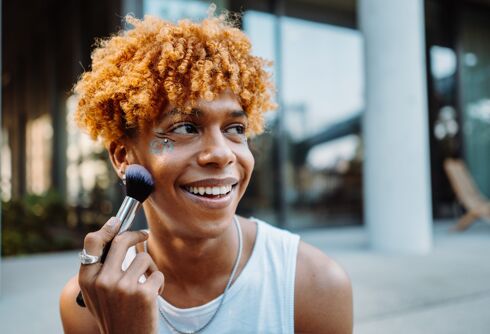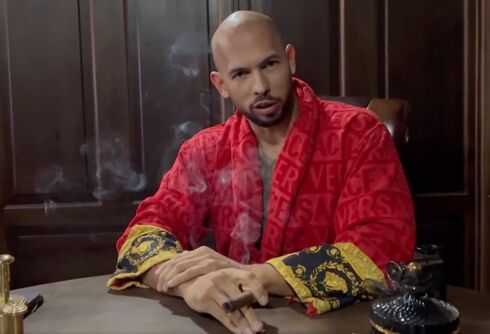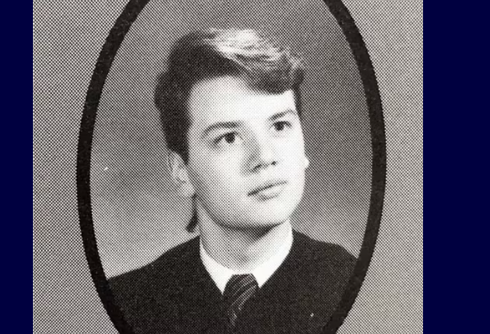Spooky season means more than just putting on your scariest — or, if you’re a certain type of gay, sexiest — costume and partying well past the witching hour. The days leading up to Halloween are a perfect time to queue up a slew of horror movies for your own private fright fest. And as Derek Le Beau, the film buff behind Queer Cinema Archive, explains, LGBTQ+ people have a very unique relationship to the genre.
“So many of us are drawn to horror,” he says. “I think part of that is because for decades it was one of the only genres where we had representation, whether it was good or bad.”
Related:
5 iconic films that have defined the queer experience
New York’s LGBTQ+ film festival, NewFest, is celebrating its 35th anniversary. So we asked staff about the most influential films it has shown.
On his Queer Cinema Archive Instagram and TikTok accounts, Le Beau exhaustively catalogs and analyzes LGBTQ+ representation and queer coding across a wide spectrum of films. He’s covered pretty much everything, from classic Hollywood pictures like Morocco to recent gay rom-coms like Fire Island. Who better to walk LGBTQ Nation through the horror genre’s thorny history of depicting queer and queer-coded characters, and to give us recommendations for our pre-Halloween viewing?
Never Miss a Beat
Subscribe to our newsletter to stay ahead of the latest LGBTQ+ political news and insights.
LGBTQ NATION: You highlight both queer cinema and queerness in mainstream cinema. Tell me about that.
DEREK LE BEAU: I pretty much look at any movie and think, What is queer about this movie? Because our history isn’t widely discussed, people weren’t necessarily open about being queer in the past, so I think it’s interesting to look at mainstream movies, and I’ll talk about queer readings of something, which means something may not necessarily be queer, but there’s something that resonates with queer audiences. And then I’ll look into why that may be.
Specifically, queer subtext or queer coding in mainstream films is something that really fascinates me. You see that a lot on my page, because it’s something I’ve been reading about and researching for a long time, and I just find it really interesting how there are so many elements that can make that up. Queer coding is not something that is made up of one element. It could be brought in from something that the screenwriter has chosen to include, from a casting choice, or even sometimes background music to insinuate that a character is queer. They use stereotypes and stuff like that, too. There are so many possible elements to create these insinuations.
LGBTQ NATION: Let’s start by talking about queerness in mainstream horror films. How have horror films historically used queerness and to what end?
DLB: It’s complicated because we’ve essentially been in horror films since the silent era, like in all movies. But specifically, I would say queer characters started to appear a lot more during the Hayes Code era of Hollywood through queer coding. And this is where a lot of the negative tropes came from, where you would see a lot of us depicted as monsters or just morally bankrupt people or essentially queer-coded killers who would have to be punished at the end of the movie for deviating from society. And this started to change in the late 60s. We started to get a little more representation because the censorship was lightening up and eventually ended in 1968 to create this new rating system that you have in America today.
But just because queer characters were allowed to be onscreen again in the late 60s and onwards, all of these tropes had been established. So that’s why there’s so much negative representation and queer-coded villains in horror movies throughout film history. It’s obviously changed a lot in recent years, but that’s the root of all of it. We weren’t allowed to be in movies unless we were the villain.
LGBTQ NATION: What are some classic horror films in which we see that kind of representation?
DLB: One of my go-to’s for this is Dracula’s Daughter from 1936. It’s a follow-up to the famous Bella Lugosi Dracula from Universal, and this one focuses on his daughter after he was killed off in the first movie. She has inherited his vampirism, and her struggle with this mirrors queer struggles back in the day too. She’s fighting her inner urges, and she sees a psychologist for a cure. She’s also preying on both men and women, but when she’s preying on women it’s a lot more sexual. It’s pretty overt that being a vampire is associated with queerness in this particular movie. It’s obviously problematic, but it’s still kind of fun. A lot of these movies are.
LGBTQ NATION: How are explicitly queer characters treated in mainstream horror, and how has that evolved?
DLB: To bridge that gap, I’m gonna talk about Psycho, from 1960, because Alfred Hitchcock loved his queer-coded characters. And what this one did is, it uses queer coding stereotypes: Norman Bates is a soft-spoken mama’s boy, which was pretty much code back then for this character’s gay. And he was played by Anthony Perkins, who was queer in real life. Hitchcock did that quite a lot in his movies. You see that also in Rope. He cast queer actors to play the leads in that to help insinuate that the characters were gay.
Part of what Psycho also established was the extremely problematic “killer man in a dress” trope that you see especially thriving in the 80s. Which definitely created issues of representation and public image around trans issues.
It evolved not necessarily for the better throughout the decades, and within the last 20 years or so it’s starting to change a little bit more. It kind of branches off in two ways, because obviously independent queer horror has different representation than queer characters in Hollywood films. It’s harder to label any mainstream Hollywood movies as “queer horror” because they might include queer characters, but the thought first is, This movie is going to be consumed by the heterosexual masses. So, you usually only get one queer character and there’s a very specific path that they have to follow, especially in recent movies, because people are more aware of the tropes.
Like in 2009, you have Jennifer’s Body. A lot of people didn’t like that one when it first came out because it was marketed as a typical teen slasher film where the female protagonist is exploited for the male gaze. But what I find really interesting about Jennifer’s Body is that it essentially has two bisexual lead characters in it. It’s made by a female writer and director, and they cast Megan Fox, who was such a big sex symbol at the time.
But her role in that film is to subvert the male gaze. People went in expecting to see this sexy horror movie and everything counteracts her sexiness. Around that time, a lot of TV shows and movies were falling into something called the “lesbian-chic era,” which would usually have lesbian sex scenes or women making out to titillate male viewers specifically, and that’s what you think you’re going to get going into Jennifer’s Body. But it is not that. The character’s a demon and you don’t know what she’s gonna do next. The sex scenes are very bloody and she’s preying specifically on men. I think it was too far ahead of its time, because it didn’t do well in theaters. But now it’s starting to become a cult classic because people are realizing what the intention was.
An example of where queer characters are in mainstream horror right now is Freaky, another teen slasher film. That one is actually from queer creators, and it’s a mainstream movie. But because it’s a mainstream film, you only have one explicitly gay character. Although there is a lot of play with gender and attraction in it. Something that strings Freaky with the reboot of Scream from 2022 and even recently Nope — they all have one queer character, and what happens when you only have one queer character in a mainstream modern horror movie is you kind of know what path that character’s gonna go on. Nothing bad is probably going to happen to them, because people are a little more aware of the tropes. Ninety percent of the time, that character isn’t going to be the killer, they’re probably gonna survive to the end of the movie, because otherwise, both issues are problematic.
And that’s what makes independent film a little more interesting. Because it’s not necessarily made specifically for a mainstream audience. A lot are specifically made for queer audiences — you’ll have more than one queer character, which means pretty much anything can happen. Which is a lot more interesting to watch. What I think mainstream filmmakers need to understand is they need to start adding more queer characters so they’re not as hindered in that character’s path, and it’s not as predictable.
LGBTQ NATION: What can you tell me about the ways that queer filmmakers portray horror?
DLB: It’s definitely different. All bets are off as to what’s going to happen. You’ll see places that you wouldn’t necessarily see in a mainstream horror movie, like scenes happening in a gay bar or a rest stop or something — scenes of cruising. One thing that’s definitely different is the treatment of queer sexuality on screen. They’re not as scared to show queer sexuality. It’s less likely to be sanitized. A lot of queer characters you see in mainstream horror are probably not going to be making out with people of the same sex, especially if they’re men, and you’re unlikely to see a sex scene between these characters.
One good one from all the way back in 2004 is a slasher film called Hellbent. It’s a queer-created movie, and it’s centered around a group of gay friends in West Hollywood who are stalked by a sexy, muscular masked killer who’s dressed as a devil.
More recently, last year there was a film released called Swallowed, which is one that I actually hid behind a pillow through most of the movie. I have a hard time watching body horror! And this one is specifically about two friends who are forced to swallow a substance that is wrapped in a condom that they’re supposed to smuggle across the U.S.-Canada border. Basically, what’s in these condoms is actually a bug, and the bug is this monster that mirrors elements of STIs. So, it’s definitely a triggering movie for a lot of people, especially who were around during the 80s and 90s. But it’s a film that’s also not shying away from queer sexuality. And again, there’s that idea of subverting the male gaze, but specifically the gay male gaze. Something that would generally be sexy onscreen, like the main character running around in his underwear, it’s sexy, but at the same time there’s something horrific about it.
A lot of filmmakers are also very aware of past tropes, so they’ll sometimes play off of them or use them to subvert audience expectations. The other thing that can happen is they can just not give a s**t about anything. Which is interesting, because one thing that always comes up in a lot of queer movies, which sucks, is it almost seems like these movies are made with an eye toward what everyone outside of the community is going to think. It’s a lot more interesting when caution is thrown to the wind and queer filmmakers just do what they want to do. That’s kind of what’s going on in Swallowed.
LGBTQ NATION: In horror films, all bets are off.
DLB: Also, horror is such a form of escapism. It can get away with a lot more because it’s not necessarily rooted in reality in most cases. So, a lot of people take it with a grain of salt, whereas representation in other movies is more likely to matter because it mirrors reality a little more realistically.
LGBTQ NATION: Do horror movies made by and for queer audiences say anything about our anxieties or fears?
DLB: I think queer horror is like all other horror in that way because everybody is scared of something different, or they connect to horror films for different reasons. So, it’s hard to pinpoint any one thing. Swallowed is kind of playing off of the AIDS pandemic, which is an interesting choice.
There’s another interesting film that’s not actually from queer creators, but it’s an independent film called Bit from 2019. This one plays off of the lesbian vampire trope. It follows a group of female vampires, some are queer, some aren’t, but they specifically only attack bad people. They bring the main character into their ranks, and this is a trans woman played by a trans actress. It’s just an interesting sign of changing times, because it’s not only queer people who are making queer films now. And it’s one of the few horror movies that has positive trans representation and a trans lead. Horror is in a position now where it’s changing, so I think we’re going to start seeing a lot of different stories being told.
LGBTQ NATION: What kind of relationship do queer people have to horror films?
DLB: So many of us are drawn to horror. It’s one of the most popular genres in the queer community. I think part of that is because for decades it was one of the only genres where we had representation, whether it was good or bad. I think that’s one of the reasons so many of us are connected to it and why we might connect with a queer-coded villain. Or even the protagonist of the film sometimes. You watch something like Frankenstein, and it’s about this misunderstood creature on the outskirts of society that society kind of comes for, right? It’s that underlying… subtext or allegory that mirrors aspects of our own experience.
On the other side of that, a lot of popular horror films are slasher flicks with final girls. The gays, we all love our strong female characters. Even better if she’s strong and sassy!















